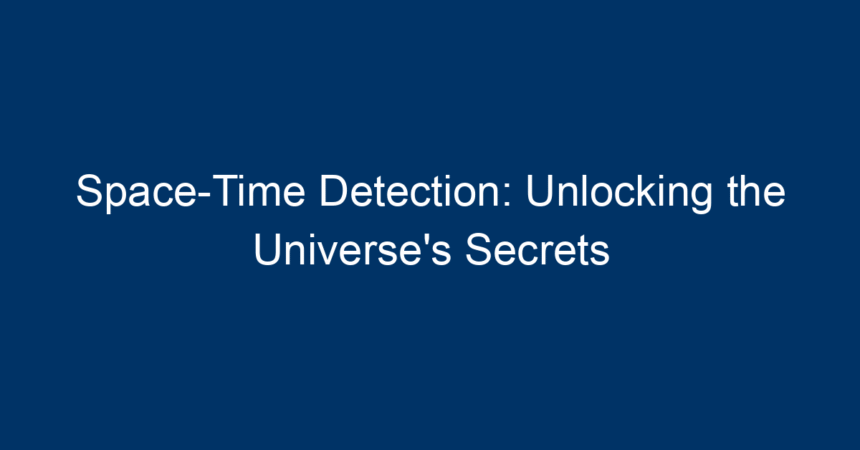Introduction
The universe, in all its grandeur, holds countless secrets waiting to be unveiled. One of the most profound concepts that scientists grapple with is the intricate dance of space and time. Within this realm, space-time detection emerges as a crucial tool in understanding the very fabric of our cosmos. Through pioneering methods and revolutionary technologies, researchers are beginning to unlock the mysteries of black holes, gravitational waves, and cosmic phenomena that defy comprehension. This article delves into the fascinating world of space-time detection, revealing its significance, methods, applications, and future directions.
The Concept of Space-Time
What is Space-Time?
At its core, space-time is a four-dimensional continuum that merges the three dimensions of space with the dimension of time into a single framework. Introduced by Albert Einstein in his theory of relativity, this concept reshaped our understanding of gravity, motion, and the universe itself. Instead of viewing space and time as separate entities, Einstein demonstrated that they are interconnected, influencing one another in ways that govern the behavior of celestial bodies.
Why Space-Time Matters
Understanding space-time is essential for several reasons. First, it provides a foundation for modern physics, including theories related to cosmology and astrophysics. Second, exploring space-time enables scientists to investigate phenomena such as black holes, wormholes, and the expansion of the universe. As we harness the power of space-time detection, we get closer to grasping complex theories that have perplexed humanity for centuries.
Methods of Space-Time Detection
Gravitational Wave Detection
One of the most groundbreaking advancements in space-time detection is the discovery of gravitational waves. These ripples in the fabric of space-time were first predicted by Einstein and were first directly observed in 2015 by the LIGO (Laser Interferometer Gravitational-Wave Observatory).
Gravitational waves are produced by catastrophic events, such as colliding black holes or neutron stars. By detecting these waves, scientists can gain insights into such cosmic events that were previously undetectable. The LIGO observatory exemplifies the principle behind gravitational wave detection, using laser interferometry to measure minute changes in distance caused by these waves—changes as small as one-thousandth the diameter of a proton.
Time-Dilation Experiments
Another captivating aspect of space-time detection involves the phenomenon of time dilation, a direct consequence of Einstein’s theory of relativity. Time dilation occurs when objects move at high speeds or are situated in strong gravitational fields. Experiments, such as those utilizing atomic clocks on fast-moving airplanes or satellites, have confirmed that time passes differently depending on the relative velocity or gravitational influence.
By accurately measuring and comparing time across different frames of reference, scientists can explore the implications of Einstein’s theories and refine our understanding of cosmic interactions.
Cosmic Microwave Background Radiation (CMBR)
The Cosmic Microwave Background Radiation provides further empirical evidence supporting our comprehension of space-time. This faint glow of radiation, a remnant from the Big Bang, permeates the universe and carries valuable information about its infancy.
Satellites like the Planck Observatory have enabled precise measurements of the CMBR, allowing physicists to draw connections between its fluctuations and the underlying structure of the universe. These studies of the early universe augment existing knowledge of cosmic evolution and contribute to our understanding of the space-time continuum.
Applications of Space-Time Detection
Astrophysics and Cosmology
The applications of space-time detection extend into the realms of astrophysics and cosmology. By studying the digits of space-time, scientists can decipher the life cycles of stars, the formation of galaxies, and the ultimate fate of the universe. Techniques such as gravitational lensing—where massive objects bend light—allow researchers to map the distribution of dark matter and unveil hidden structures in the cosmos.
GPS and Satellite Technology
A practical application of space-time detection is seen in Global Positioning Systems (GPS). The accuracy of GPS relies on understanding and correcting for the effects of time dilation caused by both the satellite’s velocity and its position in Earth’s gravitational field. Without incorporating these relativistic corrections, GPS systems would quickly become inaccurate, illustrating the profound impact of space-time detection on everyday technology.
Quantum Computing and Communication
Emerging technologies like quantum computing and quantum communication also find their roots in space-time principles. As we venture into the quantum realm, understanding the implications of space-time becomes paramount for developing secure communication systems and advanced computational models that could revolutionize our technological landscape.
Future Directions in Space-Time Detection
Advancements in Technology
As technological capabilities continue to evolve, the frontier of space-time detection will expand. Future projects like the space-based observatory LISA (Laser Interferometer Space Antenna) aim to detect gravitational waves from space, opening up a new realm of astrophysical observations. Such advancements could expose previously concealed phenomena, offering a deeper comprehension of extreme cosmic events.
Interdisciplinary Collaborations
The quest for knowledge regarding the universe’s secrets necessitates a multidisciplinary approach. Collaboration between physicists, astronomers, and technologists will enhance our understanding and lead to innovative methodologies in space-time detection. Integrating ideas and techniques from various fields can unlock insights that singular disciplines may overlook.
Ethical Considerations and Public Engagement
As we unravel the mysteries of the universe, addressing ethical considerations becomes increasingly crucial. Engaging the public through outreach initiatives, educational programs, and transparent discussions can foster a broader understanding of space-time concepts. A knowledgeable public can better appreciate the importance of scientific endeavors in cosmic exploration.
Conclusion: Unlocking Cosmic Secrets
The intricacies of the universe lie interwoven within the framework of space-time. Through innovative methods of space-time detection, we are gradually illuminating the shadows that have long obscured cosmic phenomena. From gravitational waves to quantum implications, the knowledge we glean not only enhances our understanding of the universe but also propels us toward monumental technological advancements.
In conclusion, as we stand at the threshold of a new era in astrophysics and technology, the importance of space-time detection cannot be overstated. By continuing to push the boundaries of our understanding, we can unlock the profound secrets that lie within the depths of the cosmos. The challenges ahead are vast, but so too are the rewards awaiting those courageous enough to explore them. Embrace the journey, and let’s unlock the universe’s secrets together.




